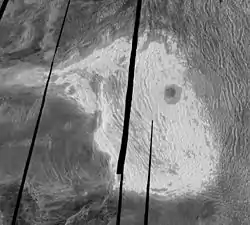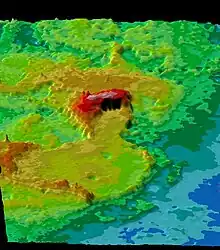 Radar image of Maxwell Montes (bright area; darker circle is Cleopatra crater; grey patch to the left is Lakshmi Planum, both embedded in Ishtar Terra) | |
| Feature type | Mountain range |
|---|---|
| Coordinates | 65°12′N 3°18′E / 65.2°N 3.3°E |
| Diameter | 797 kilometres (495 mi) |
| Eponym | James Clerk Maxwell |
Maxwell Montes /ˈmækswɛl ˈmɒntiːz/ is a mountain massif on the planet Venus, of which Skadi Mons is the highest point on the planet's surface.
General description
Located on Ishtar Terra, the more northern of the planet's two major highlands, Maxwell Montes is 11 kilometres (36,000 ft) high.[1] It rises about 6.4 kilometers above and to the east (21,000 ft above, and 4 miles (6.44 km) to the east) of Lakshmi Planum, and is about 853 kilometres (530 mi) long by 700 kilometres (435 mi) wide.[1] The western slopes are very steep, whereas the eastern slopes descend gradually into Fortuna Tessera.[2] Due to its elevation, it is the coolest (about 380 °C or 716 °F) and least pressurised (about 45 bar or 44 atm) location on the surface of Venus.[3][4]
Origins and geology
The origin of the Lakshmi Planum and the mountain belts such as Maxwell Montes is controversial. One theory suggests they formed over a hot plume of material rising from Venus's interior, while another says the region is being compressed (pushed together) from all sides, resulting in material descending into the planet's interior.[5] Broad ridges and valleys making up Maxwell Montes and Fortuna Tessera suggest that the topography resulted from compression.[2] The parallel ridges and valleys were cut by later extensional faults.[1] The extreme height of Maxwell Montes with other compressional mountain ranges around Lakshmi Planum suggests that its origin is more complex.[1]
Most of Maxwell Montes has a bright radar return which is common on Venus at high altitudes. This phenomenon is thought to result from the presence of a mineral, possibly a metallic snow. Early suggestions included pyrite[2] and tellurium; more recently, lead sulfide and bismuth sulfide.[6]
Radar mapping and naming


By using radar to probe through the permanent and thick clouds in the Venusian atmosphere and make observations of the surface, scientists at the American Arecibo Radio Telescope in Puerto Rico discovered the extensive highland on Venus that came to be called Maxwell Montes in 1967.[7] In 1978, the space probe Pioneer Venus 1 went into orbit around Venus for the purpose of making radar observations of the Venusian surface. These observations made possible the creation of the first topographic map of the surface of Venus, and confirmed that a point within Maxwell Montes is the highest point above the average level of the planet's surface.[8]
Maxwell Montes is named for James Clerk Maxwell whose work in mathematical physics predicted the existence of radio waves, which made radar, and thus the surface observations of Venus, possible.[9] Maxwell Montes, Alpha Regio, and Beta Regio are the three exceptions to the rule that the surface features of Venus are to be named for females. The name, originally given by Ray Jurgens in 1970 on the urging of Tommy Gold, was approved by the International Astronomical Union's Working Group for Planetary System Nomenclature (IAU/WGPSN) between 1976 and 1979.[10]
See also
References
- 1 2 3 4 Jones, Tom; Stofan, Ellen (2008). Planetology : Unlocking the secrets of the solar system. Washington, D.C.: National Geographic Society. p. 74. ISBN 978-1-4262-0121-9. Archived from the original on 2017-07-16. Retrieved 2016-10-16.
- 1 2 3 "PIA00149: Venus - Maxwell Montes and Cleopatra Crater". NASA Planetary Photojournal. Archived from the original on 2012-07-13. Retrieved 2009-06-11.
- ↑ Basilevsky A. T., Head J. W. (2003). "The surface of Venus". Reports on Progress in Physics. 66 (10): 1699–1734. Bibcode:2003RPPh...66.1699B. doi:10.1088/0034-4885/66/10/R04.
- ↑ McGill G. E.; Stofan E. R.; Smrekar S. E. (2010). "Venus tectonics". In T. R. Watters; R. A. Schultz (eds.). Planetary Tectonics. Cambridge University Press. pp. 81–120. ISBN 978-0-521-76573-2. Archived from the original on 2016-06-23. Retrieved 2016-10-16.
- ↑ "The Magellan Venus Explorer's Guide - The Geology of Venus". NASA JPL. Archived from the original on 2016-12-03. Retrieved 2009-06-11.
- ↑ Otten, Carolyn Jones (2004-02-10). "'Heavy metal' snow on Venus is lead sulfide". Newsroom. Washington University in St. Louis. Archived from the original on 2016-01-29. Retrieved 2012-12-10.
- ↑ Butrica, Andrew J., SP-4218 To See the Unseen, Chapter 5: Normal Science Archived 2020-11-05 at the Wayback Machine, NASA, 1996
- ↑ "Pioneer Venus 1, Orbiter and Multiprobe spacecraft". NASA. Archived from the original on 2009-10-28. Retrieved 2009-06-11.
- ↑ "EXTREME Space Venus". NASA. Archived from the original on 2009-06-05. Retrieved 2009-06-11.
- ↑ Butrica, Andrew J., SP-4218 To See the Unseen, Chapter 6: Pioneering on Venus and Mars Archived 2020-11-28 at the Wayback Machine, NASA, 1996